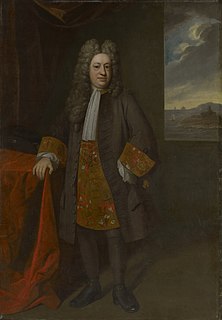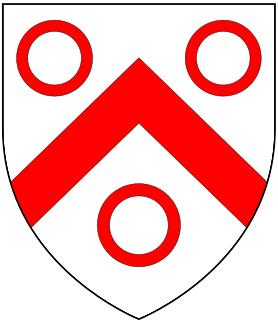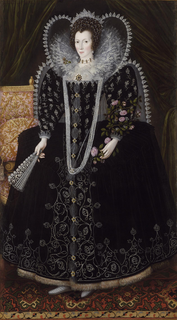
Elihu Yale was a British-American colonial administrator and philanthropist. Although born in Boston, Massachusetts, he only lived in America as a child, spending the rest of his life in England, Wales and India. Starting as a clerk, he eventually rose up to the rank of President of the British East India Company settlement in Fort St George, Madras. He later lost that position under charges of corruption for self-dealing and had to pay a fine. In 1699, he returned to Britain with a considerable fortune, around £200,000, mostly made by selling diamonds, and spent his time and wealth toward philanthropy and art collecting. He is best remembered as the primary benefactor of Yale College, which was named in his honor, following a sizable donation of books, portrait and textiles under the request of Rev. Cotton Mather, a Harvard graduate. No direct descendants of his has survived to this day.
The High Sheriff of Tipperary was the Sovereign's judicial representative in County Tipperary. Initially an office for lifetime, assigned by the Sovereign, the High Sheriff became annually appointed from the Provisions of Oxford in 1258. Besides his judicial importance, he had ceremonial and administrative functions and executed High Court Writs.
John Burke was an Irish genealogist, and the original publisher of Burke's Peerage. He was the father of Sir Bernard Burke, a British officer of arms and genealogist.
William Peere Williams MP was a politician in Great Britain. He was Member of Parliament for Bishop's Castle from 1722 to 1727. Williams was born in Greyfriars, Chichester, Sussex, England to Peere Williams and Joanna Oyley.

Sandleford is a hamlet and former parish in the English county of Berkshire. Since at least 1924, the settlement has been within the civil parish of Greenham, and is located approximately 1.5 miles (2.4 km) south of the town of Newbury.
Richard Boyle was an English bishop who became Archbishop of Tuam in the Church of Ireland. He was the second son of Michael Boyle, merchant in London, and his wife Jane, daughter and co-heiress of William Peacock. His younger brother was Michael Boyle, bishop of Waterford.

Oliver Grace, of Shanganagh, was chosen in 1689 as the representative in Parliament of the borough of Ballynakill, in the Queen's County, Ireland.

Sydmonton is a small village and estate in the Basingstoke and Deane district of Hampshire, England. Its nearest town is Newbury, which lies approximately 7 miles (11 km) north-west from the village.

Thomas Garnier the Younger was Dean of Lincoln from 1860 until his death in 1863.
Sir Peter Delmé was a notable British figure in commerce and banking in the early 18th century.

Sir William Goring, 1st Baronet was an English politician who sat in the House of Commons from 1628 to 1629.
Thomas Baker, of Whittingham Hall in Fressingfield, Suffolk and Leyton, Essex, was an English politician.

The landed gentry and nobility of Devonshire, like the rest of the English and European gentry, bore heraldic arms from the start of the age of heraldry circa 1200–1215. The fashion for the display of heraldry ceased about the end of the Victorian era (1901) by which time most of the ancient arms-bearing families of Devonshire had died out, moved away or parted with their landed estates.
Sir Timothy Tyrrell was an Englishman who served as Master of the Buckhounds to Henry Frederick, Prince of Wales and King Charles I.
Lorenzo Moore (1744–1798) was a British Cavalry officer and a Member of the Irish Parliament for the constituency of Dungannon.
Thomas William Goff was an Irish Conservative politician.

Frances Howard, Countess of Kildare, was a courtier and governess of Princess Elizabeth Stuart, Queen of Bohemia, and a member of the House of Howard.

Dr Martin Schöner or Schönerus, physician to James VI and I and Anne of Denmark.
Sir Claud Hamilton of ShawfieldPC (Ire), also called of Leckprevick, a younger son of Claud Hamilton, 1st Lord Paisley in Scotland, was a gentleman of the privy chamber of King James VI and I, an undertaker in the Plantation of Ulster, and a privy counsellor in Ireland.
Sir Claud Hamilton was constable of the Fort of Toome in County Antrim, Ulster, Ireland. He is sometimes confused with Claud Hamilton of Shawfield.









